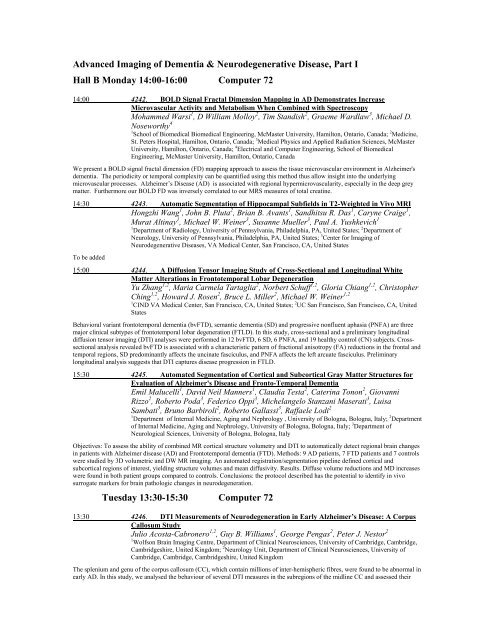Electronic Posters: Neuroimaging - ismrm
Electronic Posters: Neuroimaging - ismrm
Electronic Posters: Neuroimaging - ismrm
Create successful ePaper yourself
Turn your PDF publications into a flip-book with our unique Google optimized e-Paper software.
Advanced Imaging of Dementia & Neurodegenerative Disease, Part I<br />
Hall B Monday 14:00-16:00 Computer 72<br />
14:00 4242. BOLD Signal Fractal Dimension Mapping in AD Demonstrates Increase<br />
Microvascular Activity and Metabolism When Combined with Spectroscopy<br />
Mohammed Warsi 1 , D William Molloy 2 , Tim Standish 2 , Graeme Wardlaw 3 , Michael D.<br />
Noseworthy 4<br />
1 School of Biomedical Biomedical Engineering, McMaster University, Hamilton, Ontario, Canada; 2 Medicine,<br />
St. Peters Hospital, Hamilton, Ontario, Canada; 3 Medical Physics and Applied Radiation Sciences, McMaster<br />
University, Hamilton, Ontario, Canada; 4 Electrical and Computer Engineering, School of Biomedical<br />
Engineering, McMaster University, Hamilton, Ontario, Canada<br />
We present a BOLD signal fractal dimension (FD) mapping approach to assess the tissue microvascular environment in Alzheimer's<br />
dementia. The periodicity or temporal complexity can be quantified using this method thus allow insight into the underlying<br />
microvascular processes. Alzheimer’s Disease (AD) is associated with regional hypermicrovascularity, especially in the deep grey<br />
matter. Furthermore our BOLD FD was inversely correlated to our MRS measures of total creatine.<br />
14:30 4243. Automatic Segmentation of Hippocampal Subfields in T2-Weighted in Vivo MRI<br />
Hongzhi Wang 1 , John B. Pluta 2 , Brian B. Avants 1 , Sandhitsu R. Das 1 , Caryne Craige 1 ,<br />
Murat Altinay 1 , Michael W. Weiner 3 , Susanne Mueller 3 , Paul A. Yushkevich 1<br />
1 Department of Radiology, University of Pennsylvania, Philadelphia, PA, United States; 2 Department of<br />
Neurology, University of Pennsylvania, Philadelphia, PA, United States; 3 Center for Imaging of<br />
Neurodegenerative Diseases, VA Medical Center, San Francisco, CA, United States<br />
To be added<br />
15:00 4244. A Diffusion Tensor Imaging Study of Cross-Sectional and Longitudinal White<br />
Matter Alterations in Frontotemporal Lobar Degeneration<br />
Yu Zhang 1,2 , Maria Carmela Tartaglia 2 , Norbert Schuff 1,2 , Gloria Chiang 1,2 , Christopher<br />
Ching 1,2 , Howard J. Rosen 2 , Bruce L. Miller 2 , Michael W. Weiner 1,2<br />
1 CIND VA Medical Center, San Francisco, CA, United States; 2 UC San Francisco, San Francisco, CA, United<br />
States<br />
Behavioral variant frontotemporal dementia (bvFTD), semantic dementia (SD) and progressive nonfluent aphasia (PNFA) are three<br />
major clinical subtypes of frontotemporal lobar degeneration (FTLD). In this study, cross-sectional and a preliminary longitudinal<br />
diffusion tensor imaging (DTI) analyses were performed in 12 bvFTD, 6 SD, 6 PNFA, and 19 healthy control (CN) subjects. Crosssectional<br />
analysis revealed bvFTD is associated with a characteristic pattern of fractional anisotropy (FA) reductions in the frontal and<br />
temporal regions, SD predominantly affects the uncinate fasciculus, and PNFA affects the left arcuate fasciculus. Preliminary<br />
longitudinal analysis suggests that DTI captures disease progression in FTLD.<br />
15:30 4245. Automated Segmentation of Cortical and Subcortical Gray Matter Structures for<br />
Evaluation of Alzheimer's Disease and Fronto-Temporal Dementia<br />
Emil Malucelli 1 , David Neil Manners 1 , Claudia Testa 2 , Caterina Tonon 2 , Giovanni<br />
Rizzo 2 , Roberto Poda 3 , Federico Oppi 3 , Michelangelo Stanzani Maserati 3 , Luisa<br />
Sambati 3 , Bruno Barbiroli 2 , Roberto Gallassi 3 , Raffaele Lodi 2<br />
1 Department of Internal Medicine, Aging and Nephrology , University of Bologna, Bologna, Italy; 2 Department<br />
of Internal Medicine, Aging and Nephrology, University of Bologna, Bologna, Italy; 3 Department of<br />
Neurological Sciences, University of Bologna, Bologna, Italy<br />
Objectives: To assess the ability of combined MR cortical structure volumetry and DTI to automatically detect regional brain changes<br />
in patients with Alzheimer disease (AD) and Frontotemporal dementia (FTD). Methods: 9 AD patients, 7 FTD patients and 7 controls<br />
were studied by 3D volumetric and DW MR imaging. An automated registration/segmentation pipeline defined cortical and<br />
subcortical regions of interest, yielding structure volumes and mean diffusivity. Results. Diffuse volume reductions and MD increases<br />
were found in both patient groups compared to controls. Conclusions: the protocol described has the potential to identify in vivo<br />
surrogate markers for brain pathologic changes in neurodegeneration.<br />
Tuesday 13:30-15:30 Computer 72<br />
13:30 4246. DTI Measurements of Neurodegeneration in Early Alzheimer’s Disease: A Corpus<br />
Callosum Study<br />
Julio Acosta-Cabronero 1,2 , Guy B. Williams 1 , George Pengas 2 , Peter J. Nestor 2<br />
1 Wolfson Brain Imaging Centre, Department of Clinical Neurosciences, University of Cambridge, Cambridge,<br />
Cambridgeshire, United Kingdom; 2 Neurology Unit, Department of Clinical Neurosciences, University of<br />
Cambridge, Cambridge, Cambridgeshire, United Kingdom<br />
The splenium and genu of the corpus callosum (CC), which contain millions of inter-hemispheric fibres, were found to be abnormal in<br />
early AD. In this study, we analysed the behaviour of several DTI measures in the subregions of the midline CC and assessed their
















